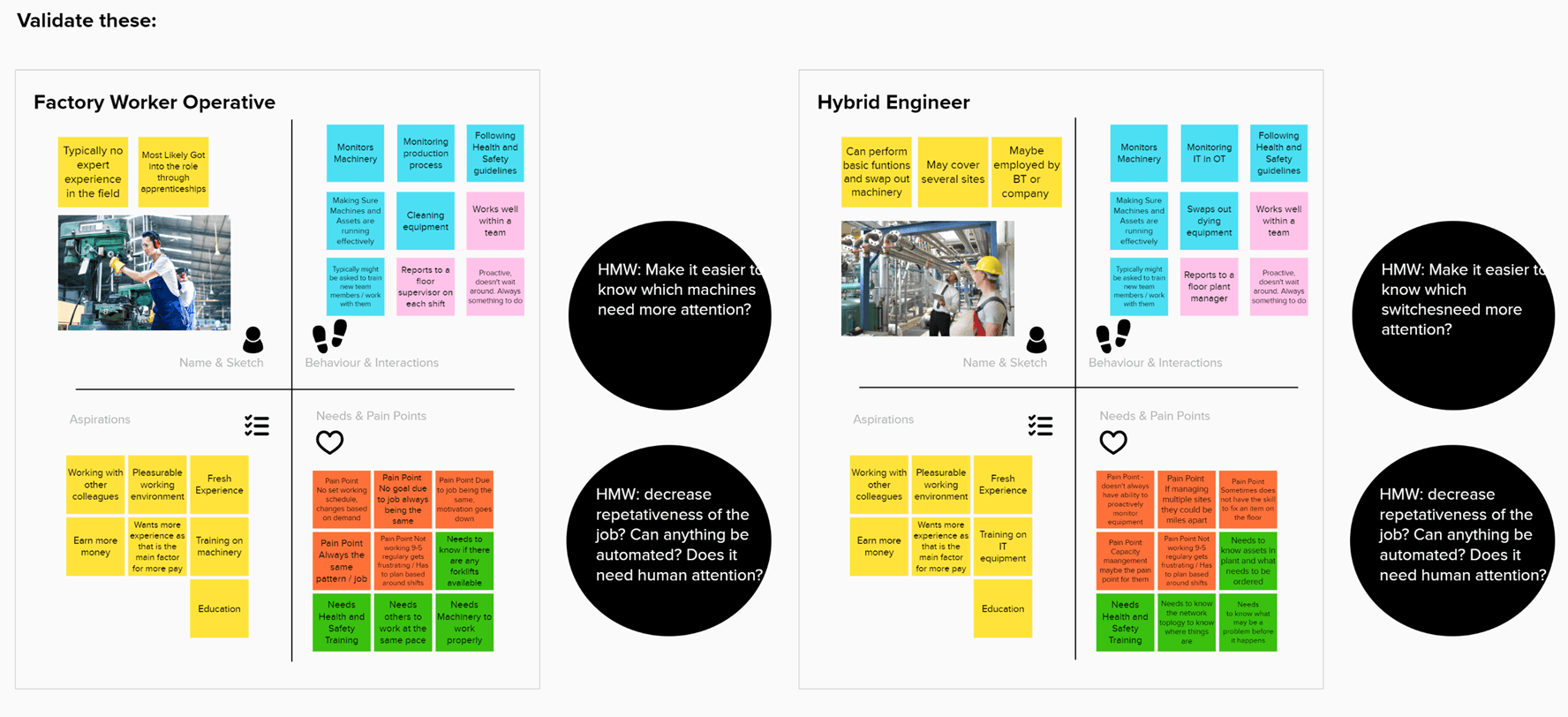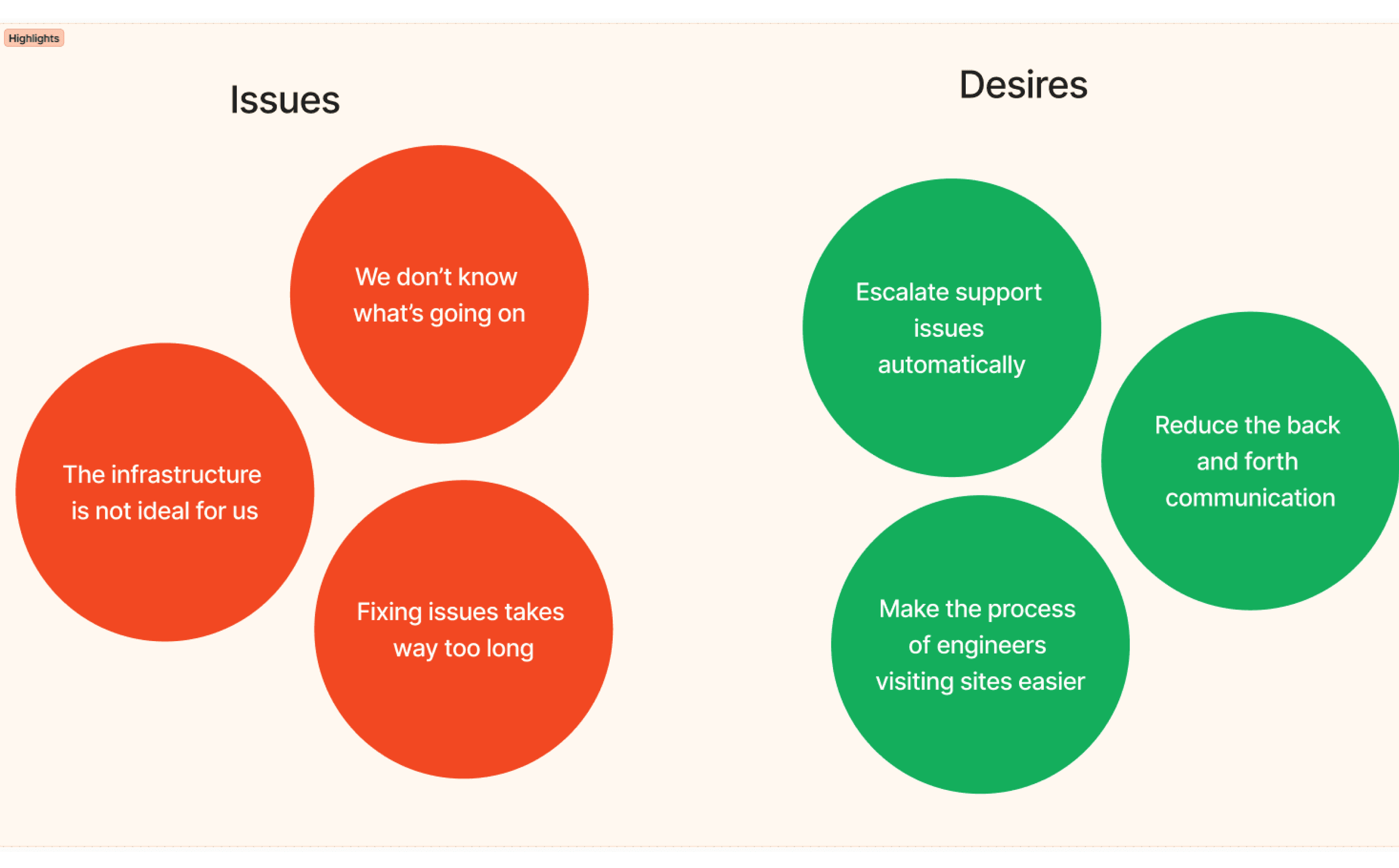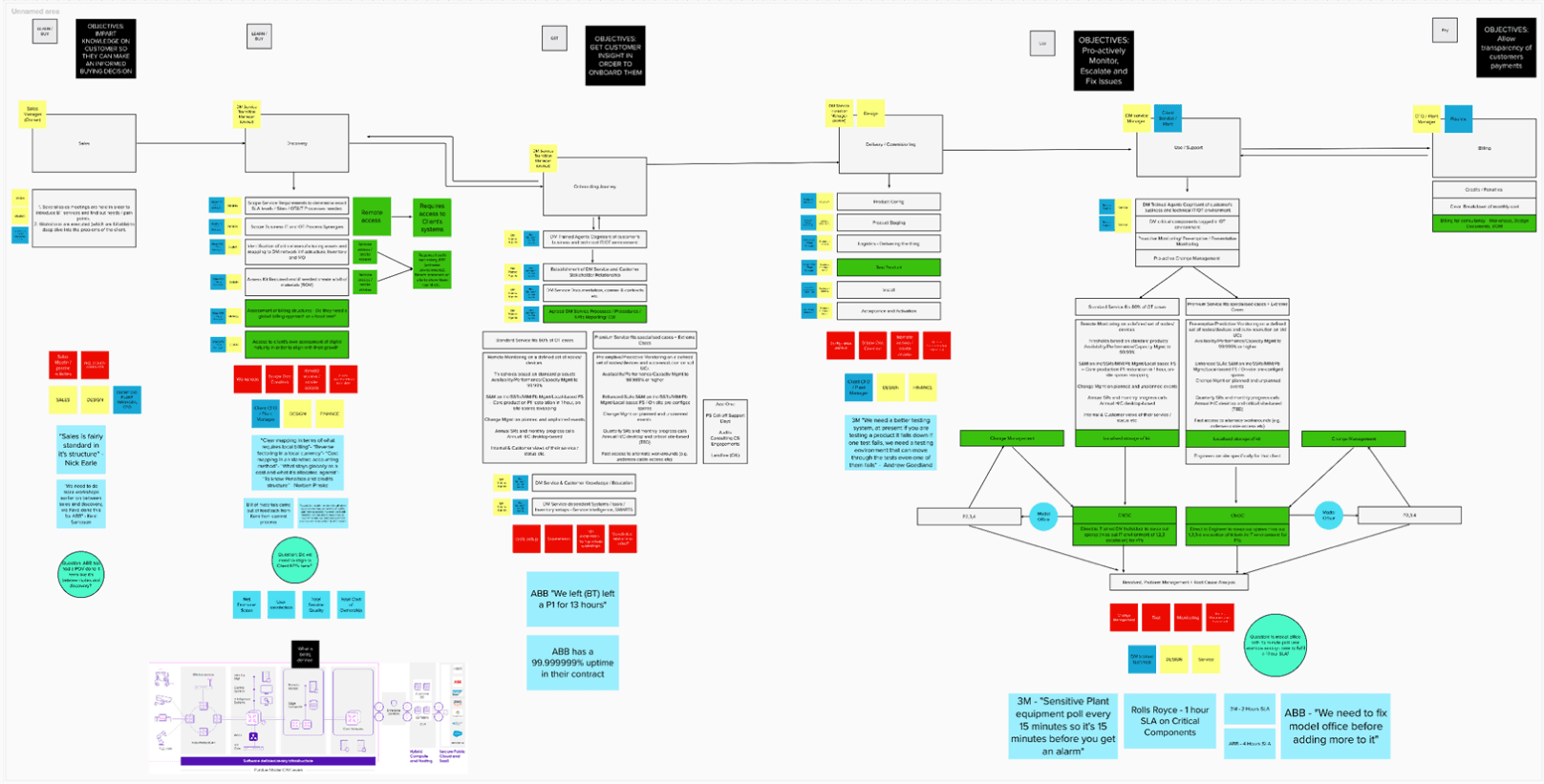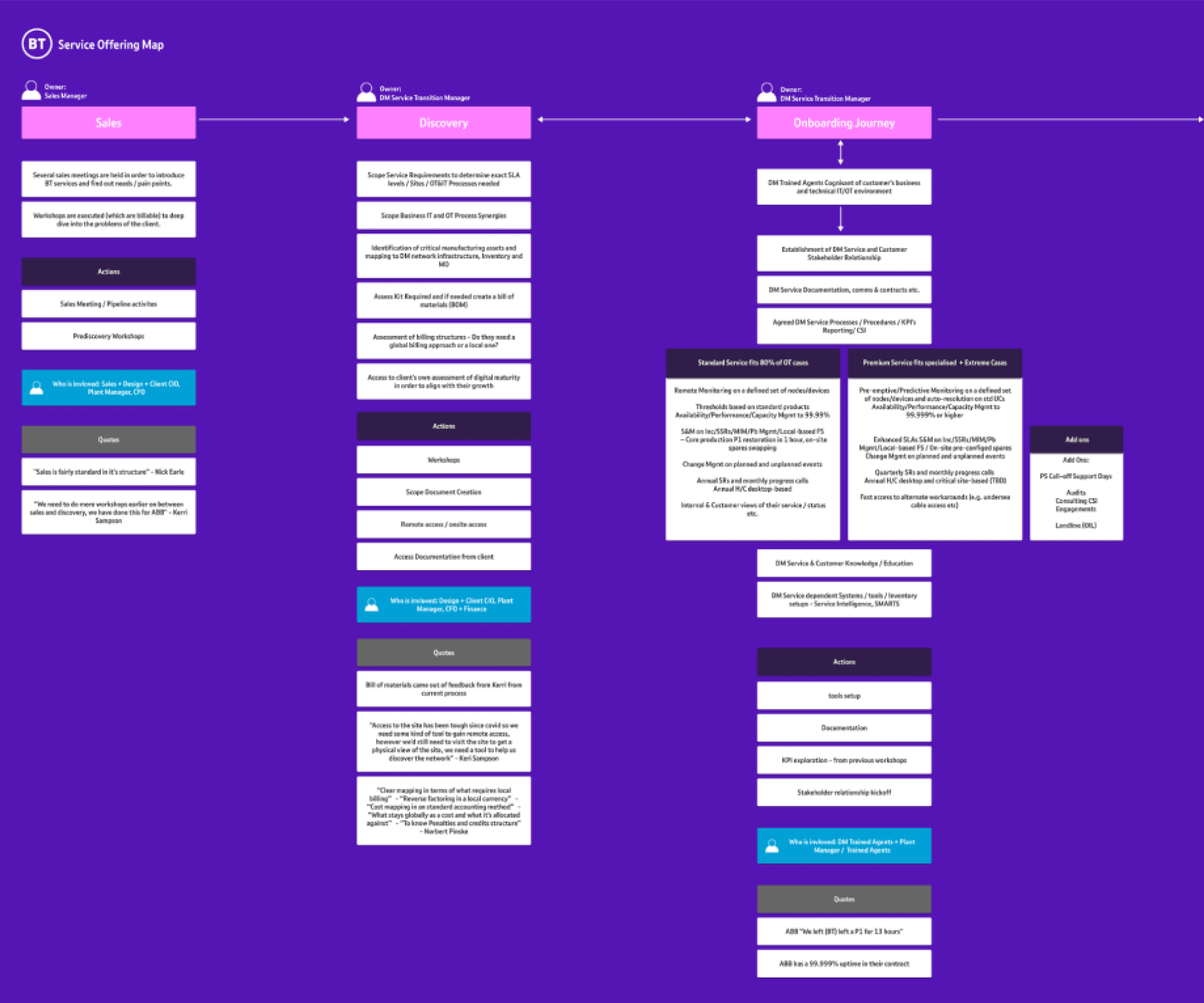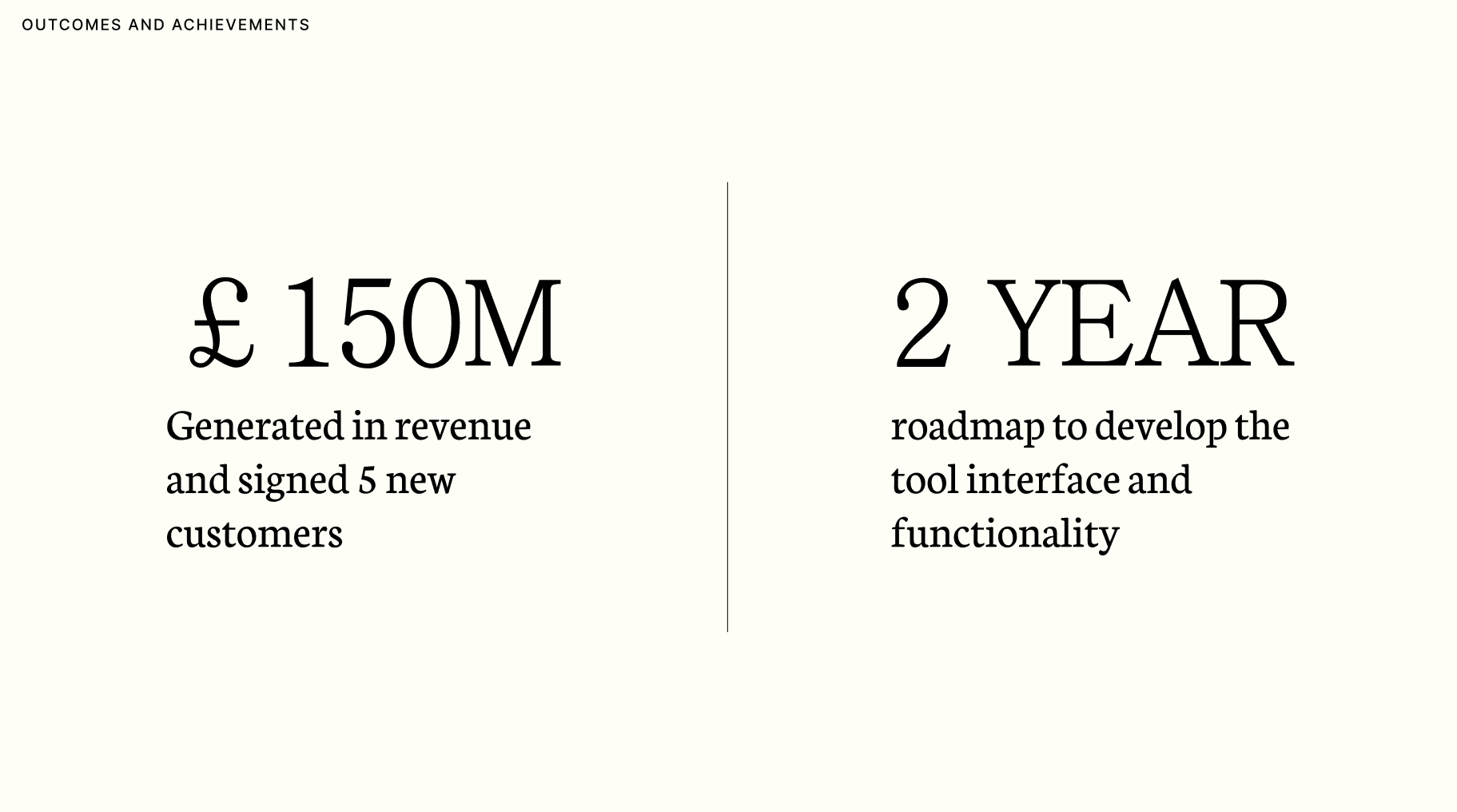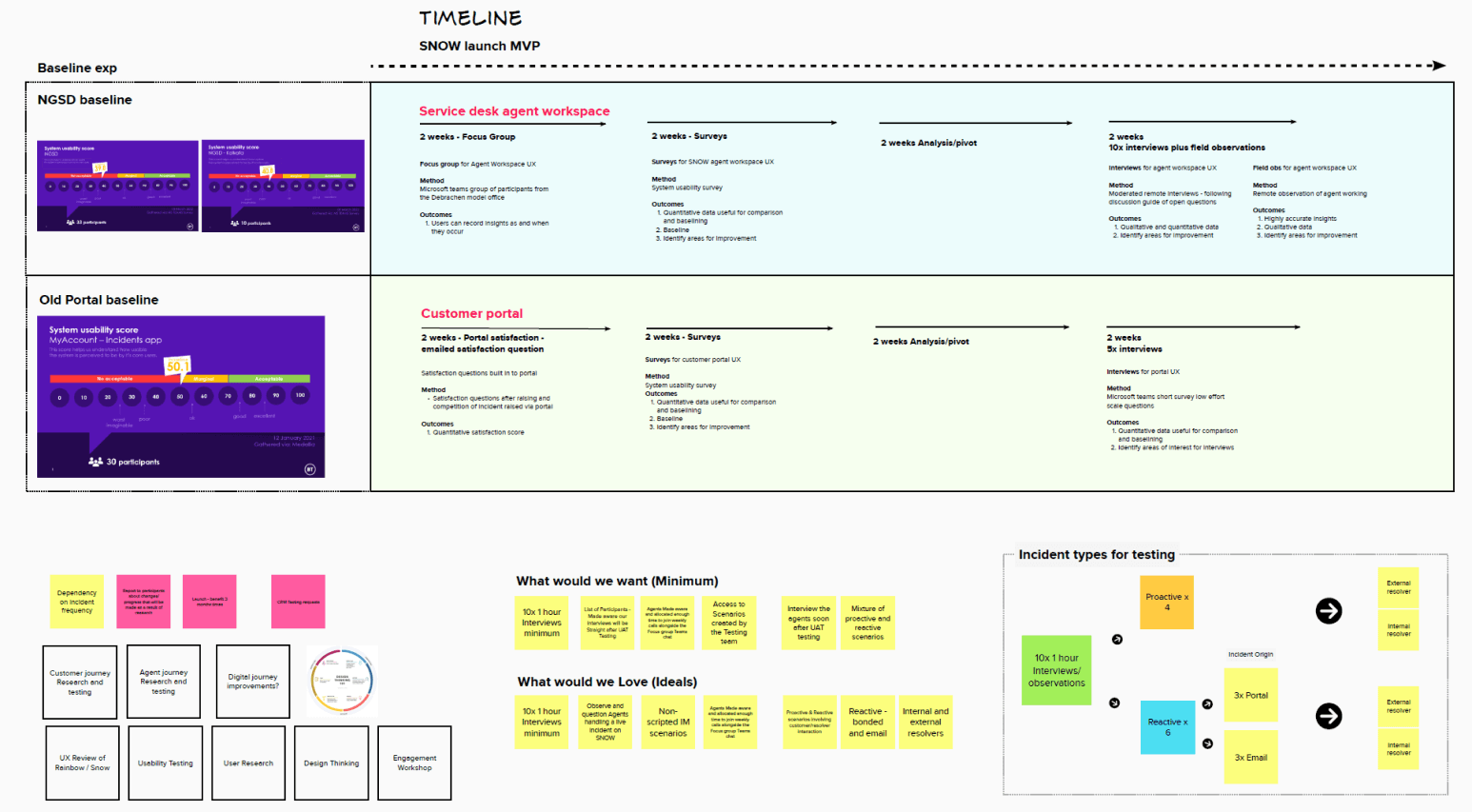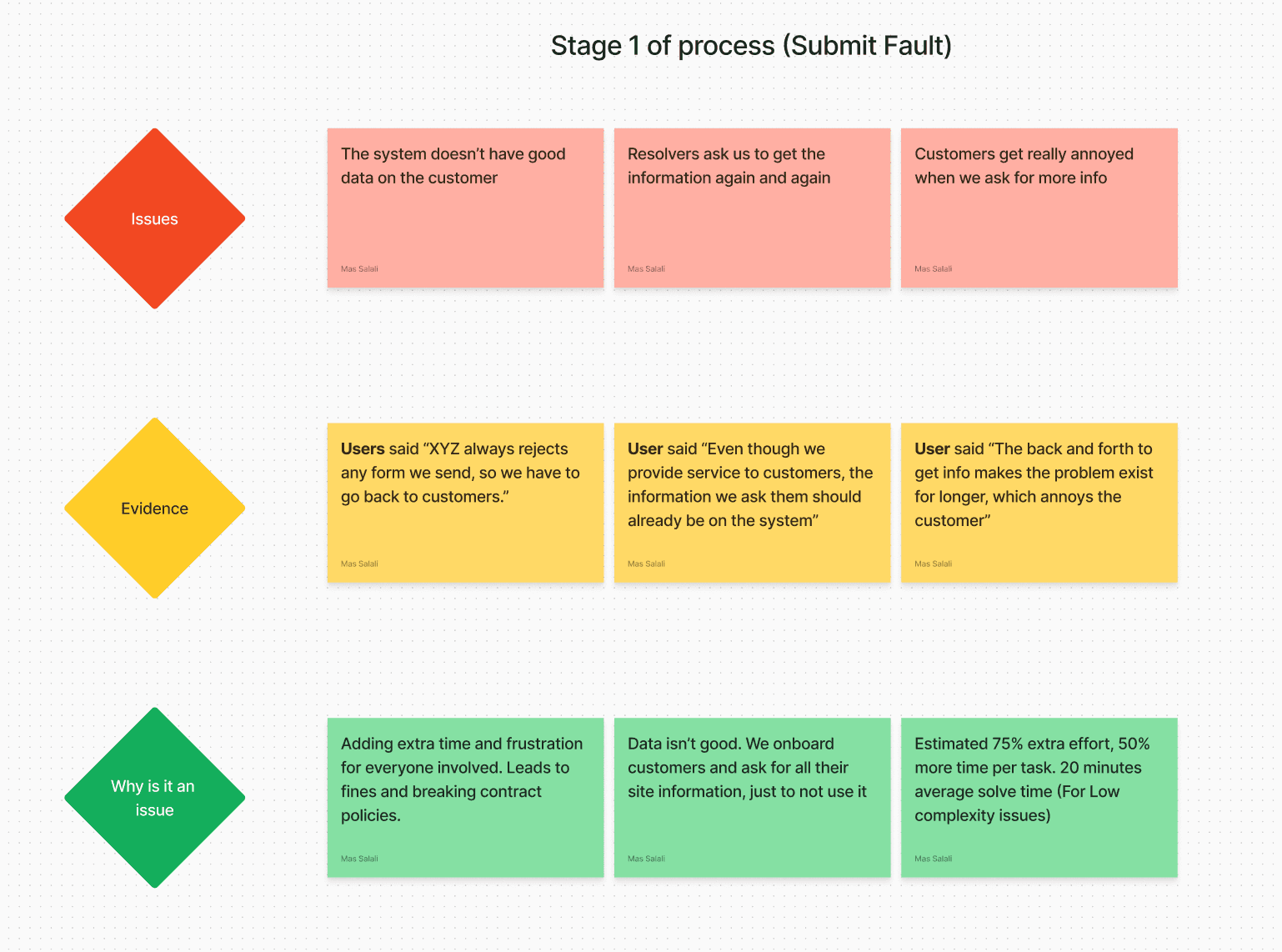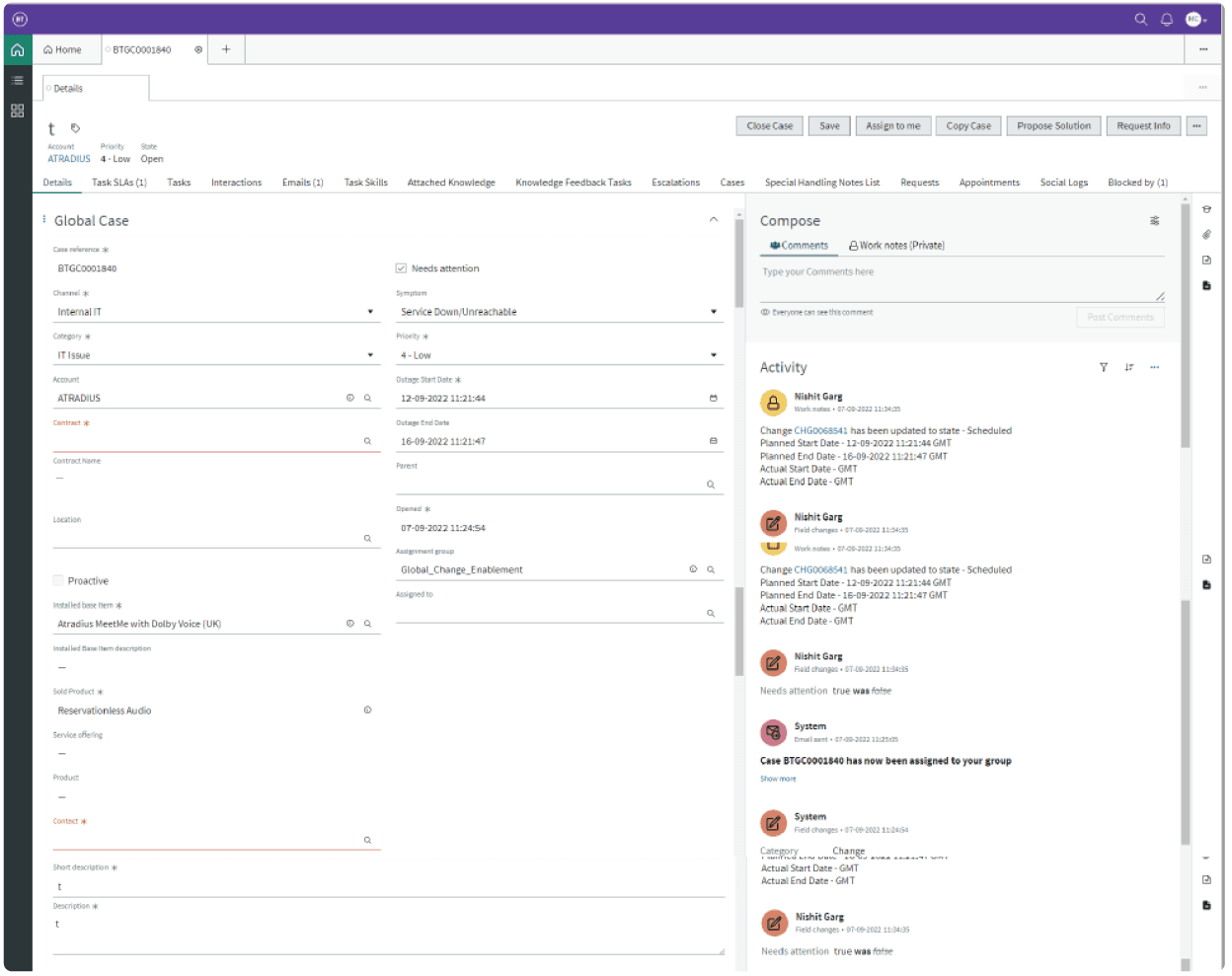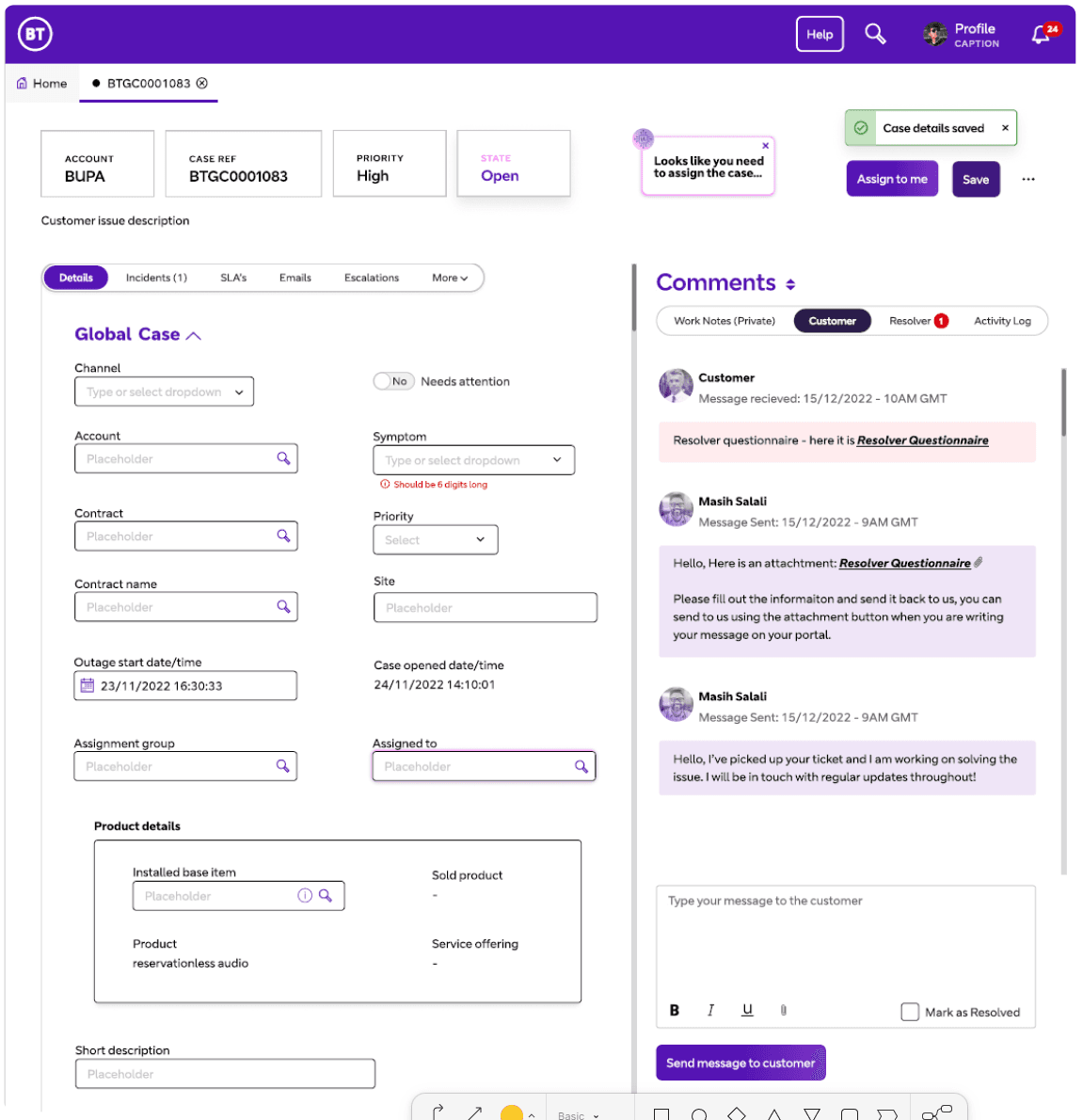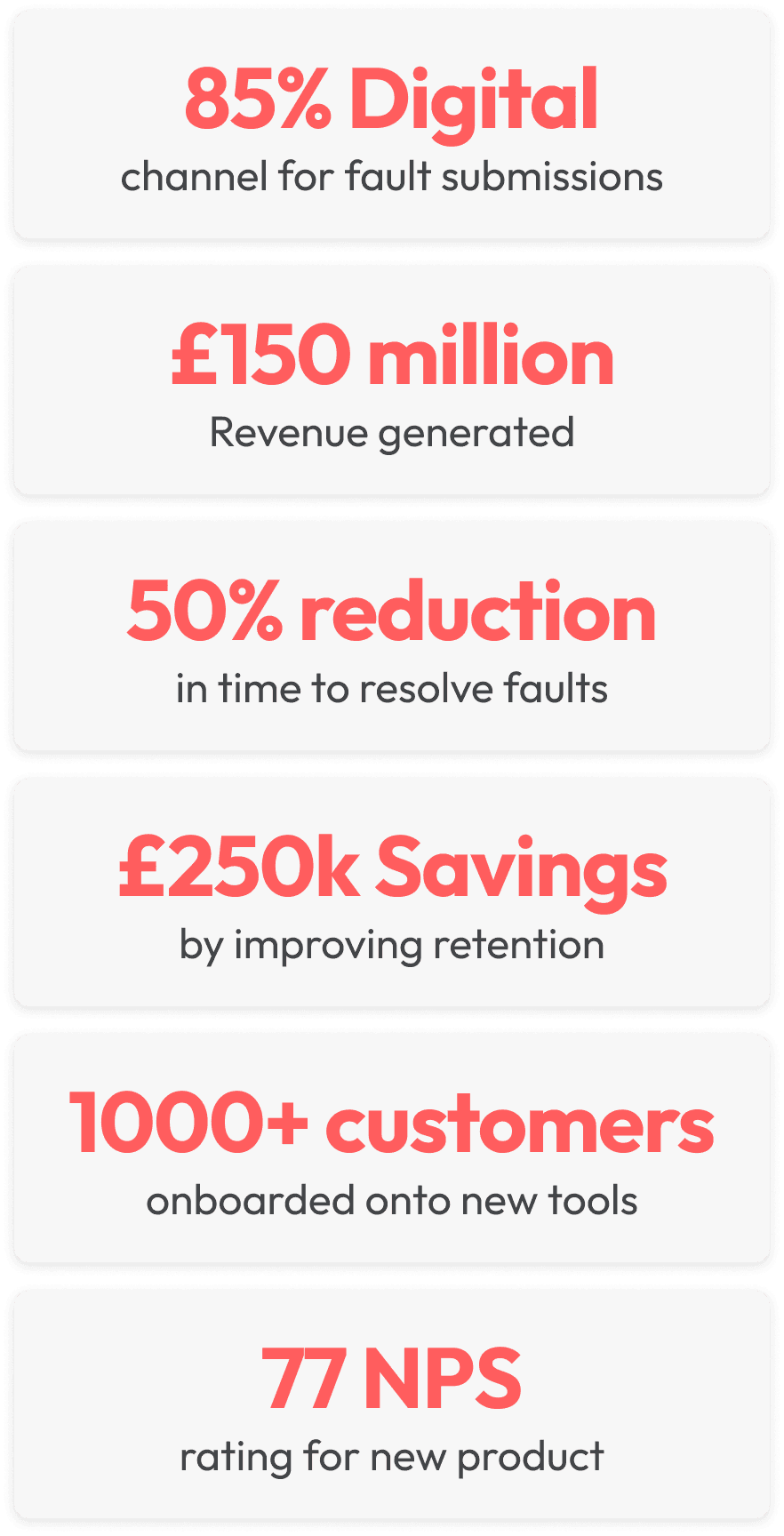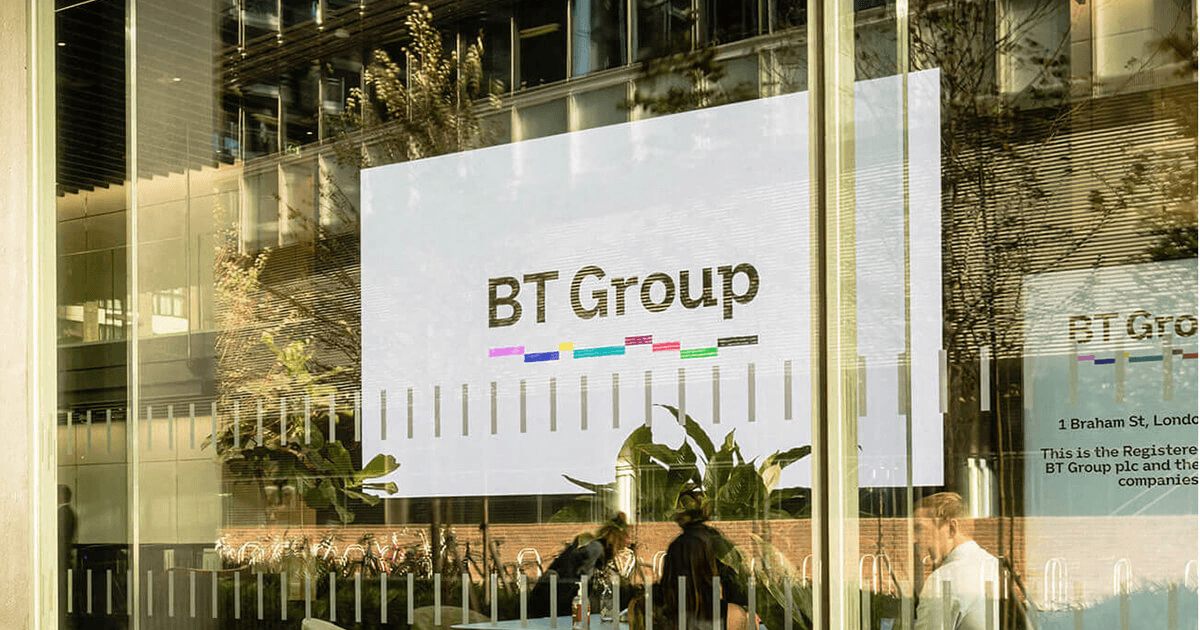
BT & Virtusa (Telecoms, Consulting)
A New service, and a New Product: Digital Manufacturing
BT is the #1 telecoms company in the UK.
The mission? Attract manufacturing clients, and under-go a digital transformation to enhance fault submission experience & capabilities.
Primary role:
Lead User Researcher & UX Feature Lead
Timeframe:
2021 - 2023
Summary:
I led the user research in a small team of 3 to create a new service to attract manufacturing giants with extreme working environments (Oil rigs, Mining sites). Later, I joined the service assurance squad to ensure our digital systems had the necessary capabilities to serve BT’s extensive portfolio of clients.
With my team, I was able to help close out 5 year contracts worth £150m, attract 5 new manufacturing customers. I assisted 14 multidisciplinary squads in paving the way to success for our digital transformation. My work as the UX Feature Lead led to 50% time reduction in resolving faults, £250k a year savings, retention improvements by 25%, digital channel usage to 85%, and 77NPS score.
The business sector and my objective.
BT is the #1 telecoms and internet provider in the UK. Internally, they have multiple business sectors. My role was within the global sector, which focuses on B2B solutions.
BT wanted to attract more customers to maintain their services, and improve their ongoing operations for their existing customer base. They wanted to tap into digital manufacturing, focusing on big manufacturers with extreme working environments.
My objective was exactly that. To explore the good things BT was doing with their existing customers, and understand what was lacking for them to sign new customers.
Goal for the projects I worked on at BT.
Collaborating with service designers and customer representatives.
To better understand the bigger picture, it was imperative to extract insights from internal teams. There was two areas I could tap into to better understand business operations.
First was the internal teams that had set up the current systems for most customers. This included service designers and engineers. My goal was to better understand how systems worked in the back-end.
Second, was to educate myself on customer relationships and customer desires. Internally, BT had employees who’s main duty was to be a customer representatives, acting as the voice of the customers. That’s where I wanted start.
The entirety of the app UI designs before I joined the company
Catching up on the As-Is and gathering all the information I can.
Understanding how the internal teams operate, i set goals to get a better picture of how I can best approach the goals set by the business.
🧬 Service blueprint review: Set up calls with internal service design teams to review and understand how systems work currently.
🔬 Connect with the user research team: Run through the currently gathered data on customers and their sentiment on services provided by BT.
🔎 Review current stack of personas: Search the depository for the current set of personas and proto-personas on who uses our systems and what they require.
💭 Run workshops with customer representatives: Future mapping workshops with CRMs (customer relation managers) to understand what’s good, what is bad, and customer desires.
🎯 Use gathered information to create an action plan: Once I’ve gathered all the data, I will start to create an action plan on where to continue and what tasks to complete.
Taking this approach allowed me to review all current data the business held on their systems. The most important thing was to avoid any contact with customers for the time being.
Why? It was so I wouldn’t ask any questions they had already answered to other internal teams, which might result in customer frustration and damage relationships.
Highlights of some of the things I found out after running workshops.
How the business approached customers to get buy-in.
During our initial round of discovery, I had the opportunity to team up with business analysts and sales staff to better understand how BT would approach customers to better understand their needs all the way to deploying their new service.
First Contact and sales: The initial part of the process. No firm plans are made, simply either a pitch from BT or customer requesting a service.
Workshop: The initial workshop. During this step, BT and their teams get together with the customer to better understand how their business operates.
Discovery: During the discovery phase, BT works with the customer to extensively cover any areas or capabilities needed for a service. In most cases, “add-ons” are added on top of the default service package.
Onboarding: During the onboarding phase, BT works on setting up the customer on their systems, setting up the customer portal centre, and adding all of their site information into their data base.
Delivery / commissioning: After a lengthy process, BT ships and start delivering the services and setting up everything for the customer.
Support: At this point, BT will support the customer until the end of their contract with support, fault submissions and keeping their systems running.
The touch points for our storyboarding workshops.
Shining a light on the problems with the process.
During our discovery of how BT approached the customers, we presented a brief understanding under each step to our participants. This helped us communicate how we, the business, thought the process happened step by step.
However, this was far from the reality. Here are some massive problems we found:
Customers were left out of the loop after the first sales call
Customers didn’t know how much budget to set aside for the service, as budgeting calls never happened until the end
The service offerings were just not right, leading to Bespoke services that took a lot of time to deploy, rushed products, and an unhappy customer in the long run
The process didn’t have any room to support customers with extreme work environments
Data held on the customers was so outdated, nothing would get solved unless the customer called up and gave the correct information
There was no way to know how the systems were doing, and any downtime problems was a surprise after deployment of services
There were more problems with the support stage of this process, but I will cover that later in this case study.
Mapping out the service flow. Anything with a colour is new additions.
Creating the new service, for extreme environments.
After 3 months of research, data analysis, talking to internal teams and customer representatives, we were able to output 2 thing.
A complete new service offering
A concept for a new product for Service Intelligence (BT product)
The new way to approach customers.
A single pane of glass, showing customer service status and info.
Along with our new service offering that focuses on all customers, and enables new avenues to attract customers with extreme work environments; we wanted to tackle another problem.
Service Intelligence is an automation and monitoring tool (short version), that essentially helps BT and customers manage their services. However, it’s all in the back end. No information is given to the customer, leaving them in the dark.
Using all the insights and data we gathered, from all of our complex customers, we put together a wireframe for a new product. This would act as a front-end interface for service intelligence.
Service intelligence concept
Benefits of the above interface for customers.
Although our first goal was to offer a desirable service that met the needs of our manufacturing customers with extreme environments (oil rigs, mining sites etc), we wanted to improve the experience when the service was deployed.
Using all the data we gathered thus far, we created a interface wireframe for BT’s internal monitoring tool, service intelligence.
This would help customers:
Have a single pane of glass view for all their services and operations.
Shows customers the health and status of their services.
Clearly highlights when there are planned maintenances, so they can expect and manage their back up services to keep their operation running 99.99% of the time
Allows customers to view all of their operations globally. Meaning if a customer has sites located in different countries, they would have eyes on it.
Inventory management section allows customers to understand what spare parts they have at the site, to avoid any risks with their service uptimes.
Gives customers an easier way to submit any faults, using a QR code.
My work on this project led to £150 million generated revenue & a 2 year roadmap.
With the great results and achievements that came out of the Big Bets project, I moved onto the service assurance squad.
My goal during this time was to tool out our new digital tools to customers.
Joining the service assurance squad.
Moving onto a new project was exciting. At this point, BT had re-structured their teams, leading to 14 multi-disciplinary teams/squads with one goal.
Digitally transform BT’s fault submission tools and systems.
My role was within the Service Assurance squad. Our OKRs for the 3 quarters were:
Understand how current systems work, by collaborating with our agents working with clients and fixing the system faults.
Conduct User research to gather data, such as average time to solve faults, how users interact with our process, and feed that information to the team
Create a source of truth for all squads, highlighting capabilities needed for each stage of a user journey to release the product MVP to our clusters of customers
User research plan.
Collaborating with UR and UX designers to split work efficiently.
Our squad included 2 Experience designers. With such a big task ahead of us, we made a plan to collaborate and help accelerate our research findings, but our main focus would be on two different areas.
We wanted to answer the following questions:
If we were to go live with the new tool, what capabilities are we missing for our current customer base?
How does the process look like for submitting faults from a customer’s portal account?
How can we gather useful data to help our 14 squads with the digital transformation?
How can we show our teams what needs to be implemented into the minimum viable product to roll-out to customers?
Worth noting, we always kept the users’ and customers’ experience at the forefront of our goals.
This case study is getting a bit long now!
Stay with me, I’ll start rapid firing some quick info and results from here onwards.
How did it go?
We conducted field observations and focus group sessions to understand how the old tool worked, what was good, what was bad.
We held about 30 user research sessions and gathered data from our internal users on what they needed for a better experience.
We created affinity maps and relayed all data to our teams, in small digestible segments with highest pain points taking priority.
We used the data to simply our service blueprint and the processes. This allowed us to reduce the time to resolve issues by 50%.
Summary of research outputs grouped based on themes, for 1 stage of the process.
Using the data to create an overview of what we need to do.
Once the research was completed, and I created a new source of truth in a form of a journey map that expanded just one user base.
Goals:
Show when and at what point of the process personas get involved.
Pin-point exactly what capability is needed, for each specific task.
4 versions, each specific for cluster of customers based on their complexity (Low, Medium, High, Bespoke).
Demo to 14 squads to plan the roll-out.
A journey map that expanded beyond just the customer journey.
Improving product user experience.
Using the data and user research we gathered we worked on a redesign of the agent view of the product. This was not helping us make a great impact as the as-is version was out-of-the-box and it came with its own problems.
Problems:
Input fields were hard to click/interact with.
Error messages where really hard to notice, and the resolution was unclear.
Comment section was hard to use, and added anxiety in case agents would sent the wrong info to customers by accident.
Too many tabs that were never used were present, making the tabs that users needed harder to find.
Out of the box version of the product - Agent view.
Product team was extremely busy with deadlines and couldn’t develop new UI.
We ran into a problem. We spoke with the product team to make changes, but they were so busy with finishing up the features and the MVP, that they couldn’t improve the UI.
We could have just put this on hold until the first iteration was out. But our improvements had so much impact in the usability of the tool, that we didn’t want to risk it. We contacted the SaaS tool experts that the company purchased the product from.
What we found out:
We could configure the UI instead.
We could make changes to behaviours of the product that would allow us to achieve our goals.
This didn’t need any development time.
Our re-designed configuration.
Let the results speak for themselves!
Here is the impact I was able to have on this project. I’m very proud of what I achieved with the team, and how I collaborated with our stakeholders to pave a clear road to success.

